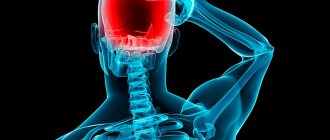Types and classification
Symptoms of agnosia vary significantly depending on the damaged area of the cerebral cortex. Most often, one type of perception is affected, but the disease can affect several systems simultaneously. There are several main types of agnosia:
- visual (visual);
- auditory;
- olfactory - impaired perception of smells;
- tactile - change in response to touch;
- taste;
- other specific varieties.
Specialists at the Clinical Brain Institute have extensive experience working with patients with agnosia. It is important to promptly determine the type of disorder and begin maintenance therapy. In addition, the first signs of the disease may indicate serious pathologies of nervous activity.
Visual agnosia
This type of agnosia is characterized by a violation of the perception of information that enters the brain through the visual analyzer. Its symptoms may differ for each patient, depending on the type and location of the damage. So, we can distinguish several specific varieties:
- object-based (develops when the left occipital lobe is damaged) - the patient sees objects well, but has difficulty recognizing them;
- prozolagnosia (damage to the lower occipital region on the right) - inability to recognize even familiar faces;
- color (damage in the left occipital region) - difficulty identifying colors and shades, as well as determining their relationship with certain objects;
- weakness of optical representations (symmetrical damage to the occipital-parietal lobe) - inability to determine the color, shape and size of objects, imagine and describe them;
- simultaneous (pathology of the occipital region) - the patient can concentrate on only one object;
- Balint's syndrome (damage to the occipito-parietal region) - inability to direct the gaze and focus on objects that are in different directions, as well as difficulty identifying objects at near and far distances.
With visual agnosia, the normal functioning of the other sense organs is maintained, and no eye diseases are detected. After rehabilitation at the Clinical Institute of the Brain, the patient adapts to everyday life and can compensate for visual disorders using other analyzer systems.
Optical and optical-spatial agnosias
Patients experience impaired ability to determine the distance between objects and navigate in space. In this category, several specific types of agnosia can be distinguished:
- Depth agnosia (damage to the middle part of the occipital-parietal lobe) - difficulty determining the distance to objects, especially those located in the anterior direction from the patient;
- impaired stereoscopic vision (pathology in the left hemisphere) - inability to recreate a three-dimensional image;
- unilateral (damage to the opposite parietal region) - one half of the space falls out of the field of vision;
- Topographical orientation disorder (parietal and occipital regions) - difficulty finding familiar objects, including home address and objects in one’s own home.
Memory and attention are preserved in optical-spatial agnosia. The patient will need help with everyday life and with new tasks, but proper rehabilitation will allow him to experience minimal discomfort in everyday life.
Auditory agnosia
With this type of agnosia, the functions of the auditory analyzer are preserved. The patient may experience various auditory perception disorders, including:
- simple - decreased ability to characterize and identify familiar sounds;
- auditory-speech - impaired speech recognition, recognition of simple and familiar words;
- tonal - lack of understanding of voice timbre, emotional coloring and other aspects.
All types of auditory agnosia develop when the temporal lobe of the brain is damaged. If the patient is unable to recognize speech, he experiences difficulties in everyday life, while his memory, attention, and the functions of the visual and other analyzers compensate for the impairment.
Somatoagnosia
Somatoagnosia is a disorder in which the patient is unable to identify and recognize parts of his own body. These are complex perception disorders associated with damage to various parts of the right hemisphere of the brain. There are two main types of somatoagnosia:
- Anosognosia is a condition in which the patient denies the presence of an illness. This may be ignoring paralysis of limbs, blindness, or speech disorders.
- Autotopagnosia is a disorder of the ability to recognize individual parts of the body. The patient experiences difficulty when asked to point to an arm, leg, or face; in some cases, there is a feeling of a change in the size of parts of the body. This group also includes somatic allosthesia, in which the patient experiences a feeling of an increase in the number of limbs.
Signs of somatoagnosia may occur in attacks. Thus, in some patients they are harbingers of an epileptic attack, and with proper treatment they are practically invisible and do not cause inconvenience in everyday life. However, they can persist permanently.
Impaired awareness of space and time
This type is considered the rarest and is associated with damage to the occipital lobe of the cerebral cortex. The patient has difficulty determining the passage of time, as well as the speed of movement of any objects. Separately, there is akinetopsia - impaired ability to identify moving objects.
State Description
Agnosia is a disorder of various types of perception that occurs against the background of unimpaired consciousness and sensitivity. With this pathology, the patient ceases to recognize stimuli, recognize objects, and begins to react incorrectly to received signals from the outside.
Disturbances in behavior and condition may occur. When the first signs of deviation appear, you should immediately undergo examination and begin treatment. You should not engage in self-therapy for the disorder, as this can only worsen the patient’s condition and provoke complications.
Diagnostic methods
The Clinical Institute of the Brain has all the conditions for a full diagnosis of patients with agnosia. At the initial stage, it is important to determine exactly what difficulties the patient has with the perception of the environment. For this purpose, there are special tests, during which the patient is asked to describe objects, sounds, and point to parts of the body. After determining the type of disorder, it is important to conduct brain imaging using computed tomography or magnetic resonance imaging. This research method will detect neoplasms, heart attacks, vascular damage and other anomalies that can cause agnosia.
2. Reasons
Various areas of the brain, cortical and subcortical, are “responsible” for the processes of perception, analysis and synthesis, comprehension and use of sensory information, and there is no clear boundary or functional division between these structures. If one of these “blocks” is damaged, the work of adjacent ones may be disrupted, and vice versa: damage or functional failure can be compensated to one degree or another by other parts of the brain.
Finally, in some cases, the organic, pathomorphological cause of agnosia cannot be established at all.
The most common factors under the influence of which recognition disorders develop include:
- disorders of cerebrovascularization (blood supply to the brain), incl. ischemic and hemorrhagic strokes and other types of stroke (acute cerebrovascular accidents);
- degenerative-dystrophic and atrophic processes in brain tissue;
- tumor processes;
- traumatic brain injuries;
- some types of mental disorders.
Any dependence on age, gender, region or other additional factors has not been established.
Visit our Neurology page
Treatment of agnosia
Treatment tactics are selected individually. The Clinical Brain Institute employs specialists with extensive experience in treating various types of agnosia. Only some cases require surgery - when tumors, aneurysms, abscesses and other structures are found that need to be removed. In other cases, treatment consists of compensating for lost functions and adapting the patient. For this purpose:
- classes with a speech therapist - special exercises strengthen neural connections and improve perception;
- occupational therapy;
- course of therapy with a neuropsychologist.
Doctors at the Clinical Institute of the Brain insist on full rehabilitation. It can last up to 10 months or more, but qualified medical care will significantly affect the patient’s well-being. Despite the fact that some changes in the structure of the cerebral cortex may be irreversible, it is possible to improve the patient’s quality of life and adapt it in everyday life.
1.General information
Agnosia is a very broad topic, and modern medicine has not fully studied it (like many other aspects of brain functioning). This term refers to numerous types of recognition disorders, differing in etiology and localization of the lesion, clinical picture and prognosis.
It is known that the five basic senses, i.e. The modes of physical sensation in humans are vision, hearing, smell, touch and taste. Any of these channels for obtaining information about the outside world (or about the state of one’s own body) can be disrupted, distorted or turned off completely. Agnosia, which represents the last, extreme version of such a disorder, as well as their partial and distorted forms (paresthesia, illusions, paragnosia, etc.) are studied by several disciplines, primarily clinical: neurology, neurophysiology, psychiatry, neuro- and pathopsychology. There are no exact statistical data on the frequency of occurrence, and they are hardly possible at all, since agnosia is most often observed in the structure of more general psychoneurological disorders.
In the current edition of the International Classification of Diseases (ICD-10, the adoption of ICD-11 is expected in 2021), the independent diagnosis “Agnosia” is placed under the heading of pathological phenomena that do not fall under any profile heading, but in reality this is extremely rare.
A must read! Help with treatment and hospitalization!
Correction of the patient's condition
Treatment is prescribed by a specialist after a thorough examination and based on the results obtained. Self-therapy in this situation is not effective and is contraindicated; it can lead to irreversible consequences of brain destruction.
To eliminate the disease, it is necessary to eliminate the underlying pathology that provoked this deviation.
In most cases, treatment lasts no more than three months - sufficient time to recover. But there are exceptions when therapy is carried out for six months to a year. A positive result depends on the patient’s age group, severity and nature of the lesion.
After the provoking cause has been eliminated, it is necessary to make some adjustments that are aimed at eliminating the disease and the disturbed state of the body. Therefore, experts recommend:
- attend speech therapy classes;
- psychotherapeutic sessions;
- study with teachers;
- spend more time on occupational therapy.
In case of agnosia, it is recommended to constantly monitor blood pressure and, if necessary, take medications that improve blood flow and nutrition to the brain (nootropics and antiplatelet agents).
If a patient has been diagnosed with a brain tumor, then surgery to remove the tumor is mandatory.
Anticholinesterase drugs are prescribed to improve neuropsychological function. At the same time, classes are held with a neuropsychologist.
What is typical for a person in such a state?
This neurological disease can only be diagnosed by a specialist based on the following symptoms:
- a broken landmark on the ground, the patient does not understand the map;
- the patient denies that he has abnormalities and defects, although there is a violation;
- the patient is not interested in the defect;
- the patient ceases to recognize objects by touch and sounds;
- the patient does not perceive his body;
- the ability to recognize faces, even close people, is impaired;
- the patient is unable to recognize complex images and also ignores much of what he sees in space.
Establishing diagnosis
This neurological disorder is not a common disease. Most often diagnosed before the age of 18.
Occurs as a result of many precipitating factors that affect each patient differently. In most cases, a comprehensive neurological examination is necessary to make a diagnosis.
The following research methods are used in diagnosis:
- magnetic resonance imaging;
- CT scan;
- neuropsychological and physical examinations.
Be sure to pay attention to symptoms and complaints, how long ago they appeared, and what could have provoked them. The specialist asks the patient to identify objects using different senses.
The neurological examination consists of the following:
- assessment of mental functions;
- assessment of visual functions;
- assessment of auditory functions.
A neuropsychological examination consists of the following: assessment of the patient’s condition using questionnaires and conversations. If necessary, the patient is referred for consultation to a psychiatrist.
Preventive actions
There are no special preventive methods, but experts recommend following these tips:
- correct and healthy lifestyle;
- giving up alcohol and smoking;
- compliance with rest and work schedules;
- proper and balanced nutrition;
- timely diagnosis and treatment of provoking diseases;
- blood pressure control.
Agnosia, although a rare disease, can lead to irreversible consequences, so it is worth paying attention to your well-being and deviations from the norm. It is impossible to make a diagnosis on your own, so you should not ignore professional help. With the right approach, you can get rid of deviations in the shortest possible time.







